If ever a phrase perfectly describes the gold sector’s M&A activities at the end of last year, it is “saving the best until last”. This is because both the number of deals and their total value reached the all-year high in Q4 2020. Total deal value and total gold ounces changing hands in Q4 represented 49% and 39% for the full year, respectively.
Pandemic caused rush to buy gold projects
Pandemic or not, it was always a great challenge for the total value of gold deals in 2020 to surpass the historical high achieved in the previous year, considering that there were two mega deals that took place in 2019. These were the merger of Newmont and Goldcorp, and the establishment of the Nevada joint venture between Barrick and Newmont. Despite the challenge, the total number of gold deals announced in 2020 was much higher than in 2019, which is a far more reliable reflection of the sector’s bullishness. The total value of deals reached US$18B last year, which was approximately just 10% less than the total achieved the year before.
Having said that, total number of gold ounces changing hands fell by a larger magnitude, 32% year on year based on the author’s recording, to 260M ounces. The decline in the number of gold resources involved in deals indicates the cost of acquiring gold ounces from the ground had increased (particularly after Q1 2020), prompting management teams to work more with early stage projects.
In the first quarter of 2020, both the number of cases and total value of deals surged due to the pandemic as industry insiders took their bullishness in gold further, and the weighted average cost of acquisition per resource ounce was only slightly less than US$24. This is because the overall quality of the projects dealt in the quarter varied. By contrast, in Q4 2020 larger companies were finally pulling the trigger on deals, with examples including the takeover of Saracen, Teranga, and Premier Gold Mines. As such, the average acquisition cost shot up to US$79.3 per total resource ounce for the quarter.
Without considering the quality of the projects, the total weighted average of acquisition ounces in 2020 was US$54.7 for the whole year, just a tad above 2019’s average price of US$52.8. To put this in context, the largest deal in 2019 belonged to Newmont offering around US$70 per ounce (not including by-products) taking out Goldcorp, while in 2020, the largest gold deal was Northern Star Resources paying US$245 per ounce to merge with Saracen Minerals.
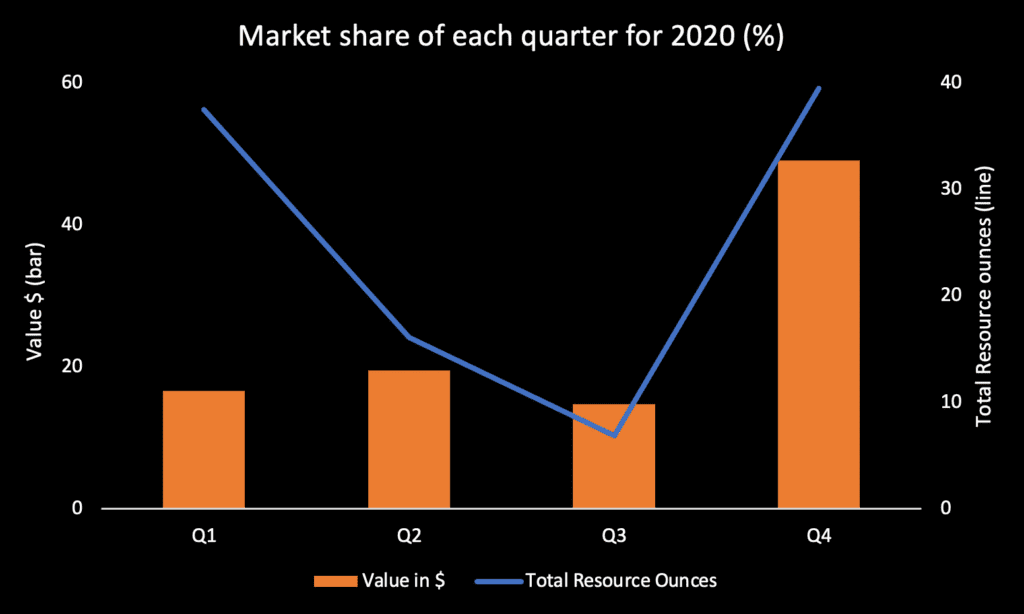
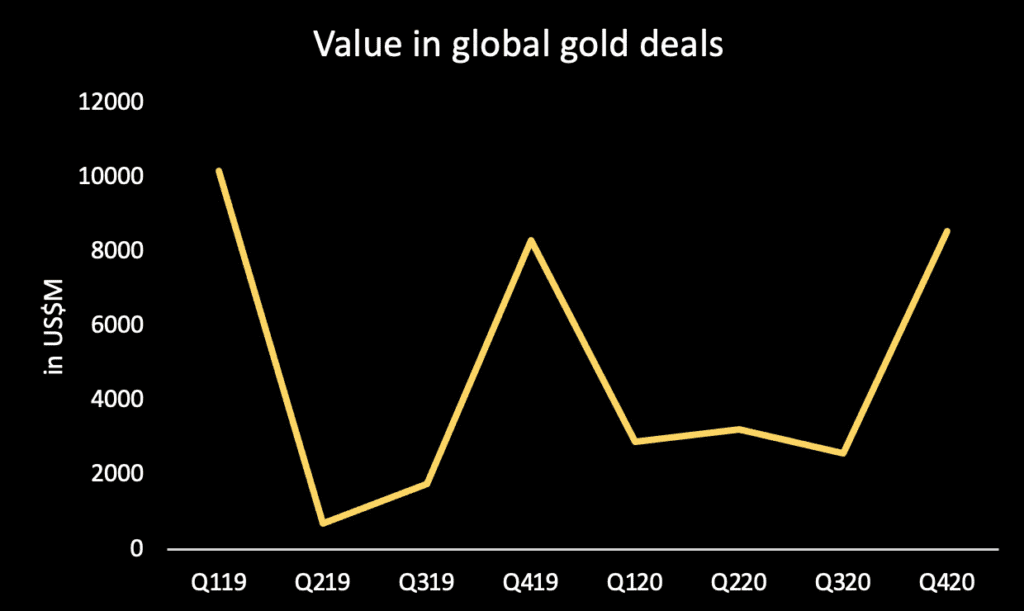
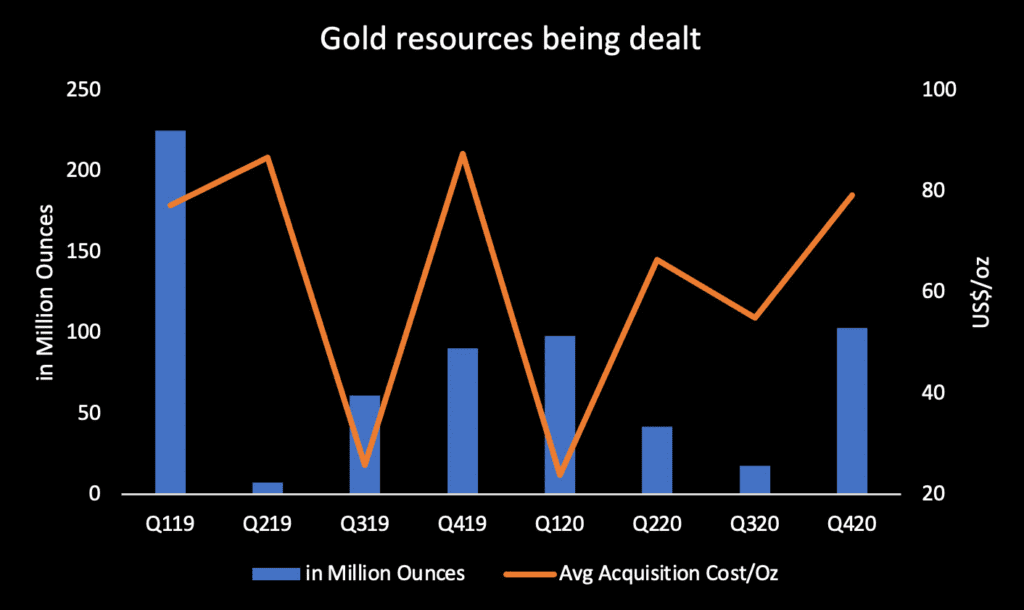
Out of the top five deals, Endeavour Mining was involved in two of them, with total gold resources increasing by 20 million ounces and annual production increasing by 800,000 ounces. Their property portfolio now spans Senegal, Côte d’Ivoire, Burkina Faso, and Mali. With an expected gold production of over 1.6 million ounces in 2021, it is already the largest gold producer in West Africa. Having said that, the author sees potential for further exploration and discovery just waiting to be unlocked in Endeavour’s portfolio, and it may be best for shareholders if the company decided to spin off those assets into a new listing company, or sell them to another junior in return for shares.

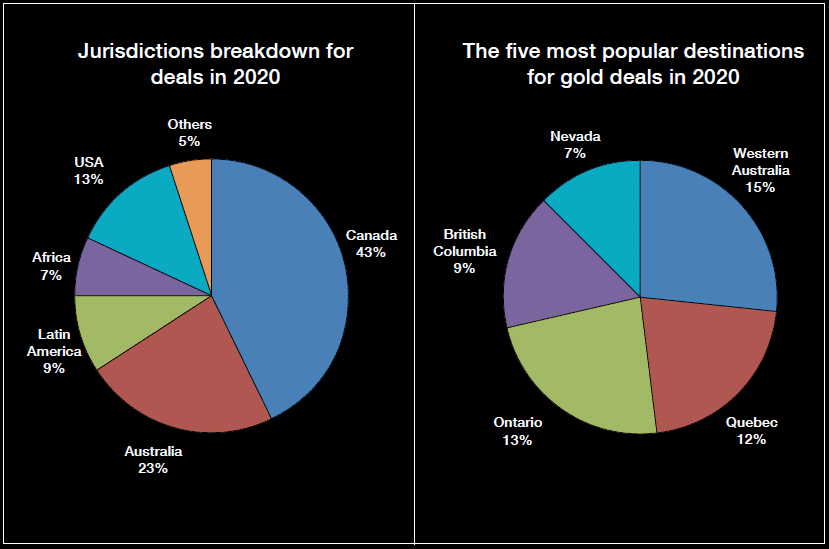
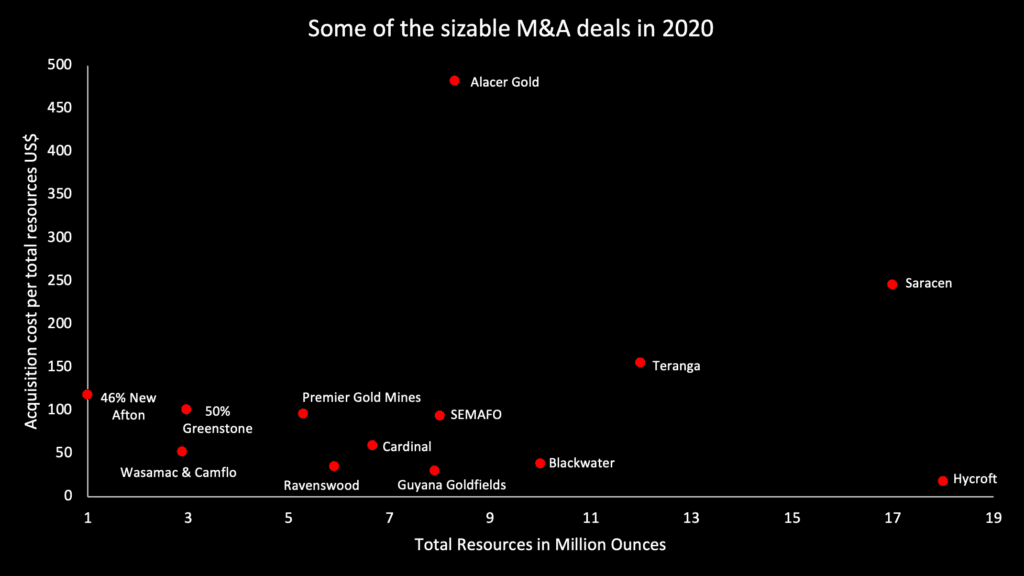
There are some sizeable deals that the author has not put into the graph above. For example, Seabridge Resources paying just US$3 per ounce to acquire the Snowfield project, with an intention of increasing more leverage to the higher gold price rather than production in the near future.
Western Australia the No.1 choice among gold jurisdictions
In terms of the location with most highly sorted gold projects, Canada was most prominent last year. Perhaps this is because projects in Canada are closer to the largest global capital market. However, if we break down the data further, it comes as no surprize that Western Australia is the most popular region among gold companies in which to work. After all, according to the Fraser Institute, Western Australia is one of the best mining jurisdictions and its mineralization is rich enough for a very decent chance of making a discovery.
Pandemic or not, it was always a great challenge for the total value of gold deals in 2020 to surpass the historical high achieved in the previous year.
During the first half of 2020, Quebec was leading the charge as the most popular destination in which to work. That was until the third quarter of the year when the number of deals in Western Australia surpassed those in Quebec. Even Ontario did more deals than Quebec by the fourth quarter, which put the province in third place by the end of the year.
Companies began working in less popular regions during Q4 2020
There is also a tendency among companies to go into the less popular regions, including Newfoundland, New Brunswick, Africa, and Latin America towards the end of the year. One of the regions that the author likes for discovery potential is Scandinavia as the existing mining infrastructure and the adequate system of law should help to lower risk in terms of costs and stability.
With so much money already printed by the Federal Reserve in 2020, and they have no interest in raising rates any time before 2023, gold has become ‘undervalued’ again relative to mainstream assets.
In recent years, there have been quite a few interesting stories about the world of gold exploration, with a staking rush occuring in a few hotspots, including in the Australian states of New South Wales and Victoria. An interesting copper gold discovery at Boda & Kaiser has caused a staking rush in New South Wales, with companies hoping to find the next big copper porphyry system. Meanwhile, with Fosterville mine now one of the most profitable gold mines in the world, companies have staked all the ground in the area, hoping to find the next Fosterville. The Victoria State Government believes there is more gold to be discovered. Last but not least, the exceptional drilling programme conducted by Newfound Gold has also induced a staking rush in Newfoundland.
Looking forward in 2021, the sentiment in gold has definitely cooled down. The market has turned its focus to cryptocurrencies and is betting on an economic recovery when the pandemic comes under control. Having said that, with so much money already printed by the Federal Reserve in 2020, and they have no interest in raising rates any time before 2023, gold has become “undervalued” again, relative to mainstream assets.
Meanwhile, there have been more and more fund managers (generalists) thinking the recent surge in the U.S. bond yield is an indication of rising inflation in the future, and they have started to place their bets accordingly, in the hard assets class.






